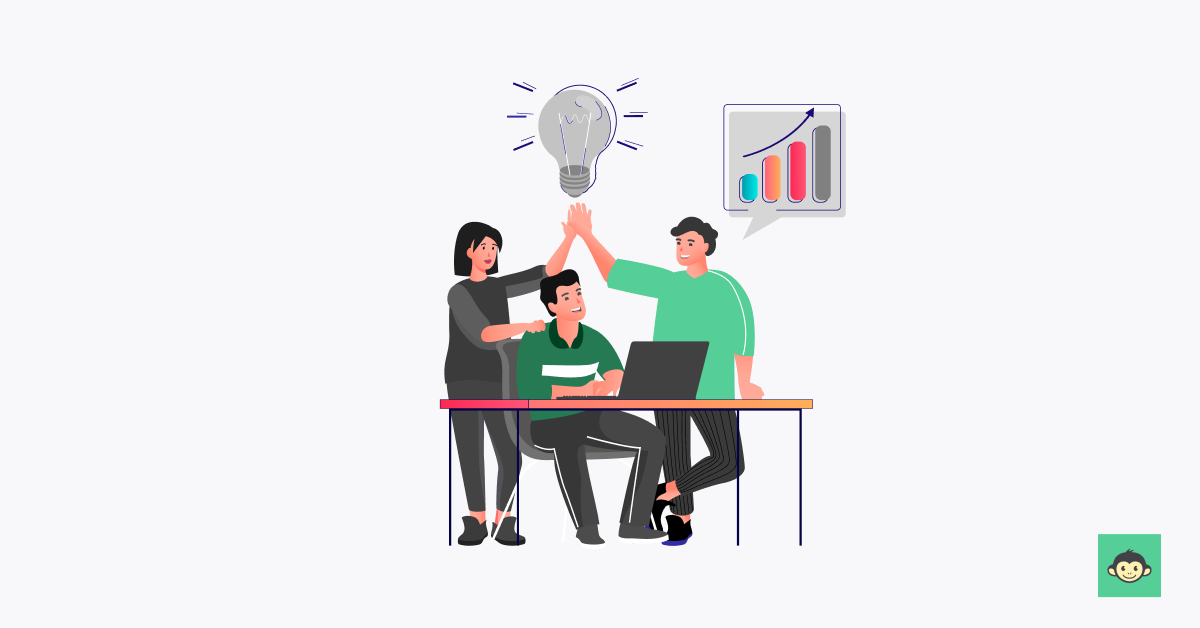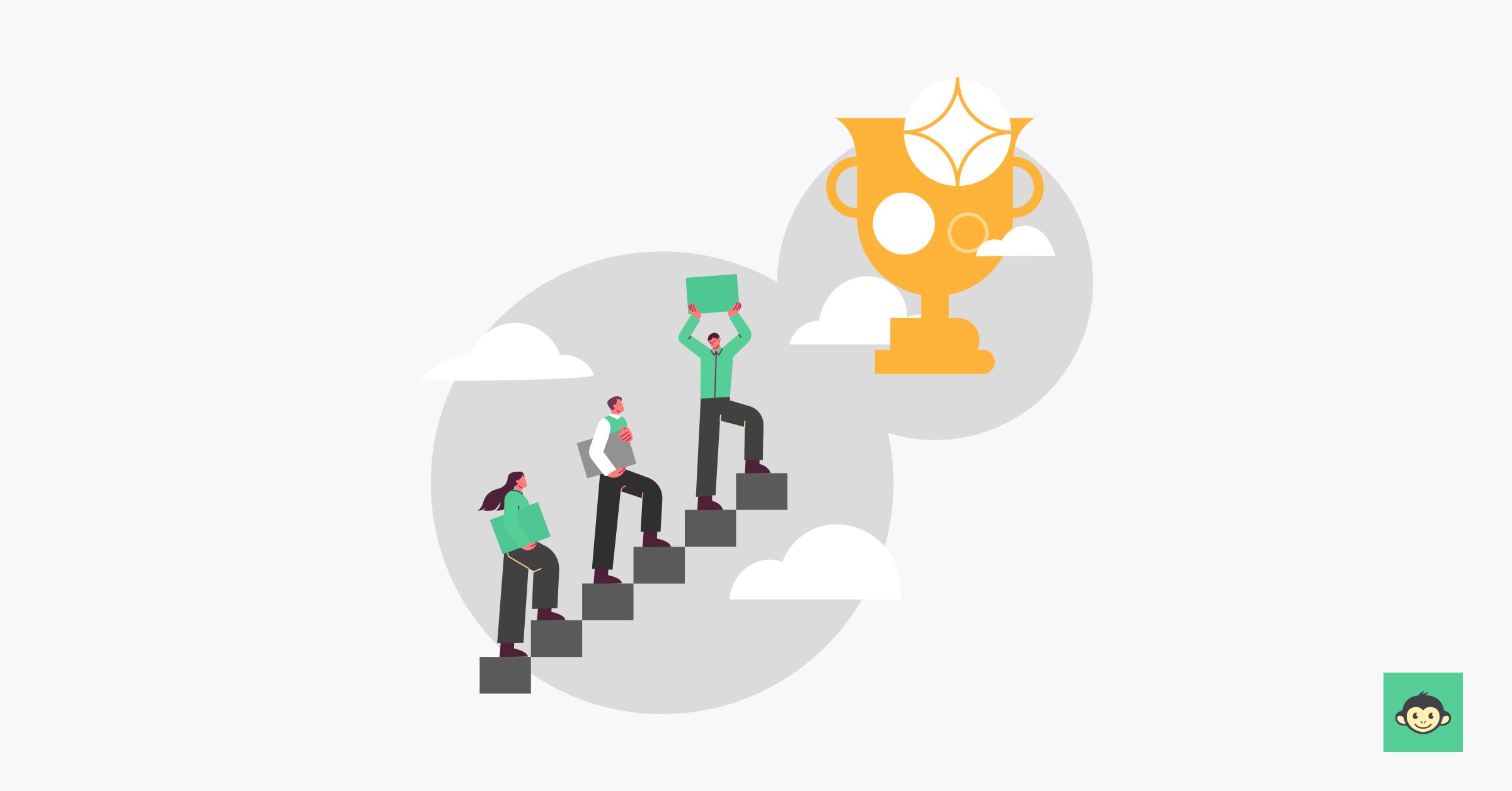105+ Employee recognition examples to supercharge your team and drive impact in 2024

Did you know that organizations with strong recognition programs have 31% lower voluntary turnover rates?
By incorporating recognition strategies into their agendas, organizations can tap into the power of appreciation to create a company culture that attracts, inspires, retains top talent, and aids in company's success.
From personalized thank-you notes and peer-to-peer shoutouts to innovative approaches like flexible work arrangements, the employee recognition landscape for 2024 offers a myriad of exciting possibilities.
These examples are not just based on theory, but on real-world success stories and empirical research, ensuring their effectiveness in driving employee engagement and motivation.
Join us on this journey of discovery as we unveil the ten captivating employee recognition examples for 2024.
What is employee recognition?

Employee recognition refers to acknowledging and appreciating an employee's contributions, efforts, and achievements in the workplace. It is a fundamental aspect of effective employee management and organizational culture.
Employee recognition programs aim to reinforce positive behaviors, motivate employees, and enhance job satisfaction.
Recognition can take various forms, such as verbal praise, written acknowledgments, awards, bonuses, peer recognition, promotions, or public recognition and celebrations. The key objective is to make employees feel valued, validated and appreciated for their hard work and dedication.
Extensive research supports the importance of employee recognition. According to a study, employees who receive regular recognition are more likely to be engaged, exhibit higher levels of productivity, and demonstrate greater loyalty to their organizations.
Additionally, credit and recognition efforts play a significant role in reducing turnover rates and enhancing employee morale and job satisfaction.
Effective employee recognition programs are based on fairness, consistency, and inclusivity. They should align with the organization's values and goals. Recognition should not be limited to exceptional achievements or major milestones; it should also extend to everyday contributions and efforts.
Managers play a crucial role in employee recognition by actively observing and identifying employee accomplishments. Timely and specific recognition, tailored to individual preferences and strengths, holds a more significant impact.
Further, peer-to-peer recognition programs foster a culture of appreciation and collaboration, allowing employees to recognize and commend each other's contributions.
Organizations can also utilize technology platforms or software to streamline the recognition process and ensure consistent implementation across teams and departments. These platforms often provide a centralized system for managers and employees to send, track, and document recognition moments.
Employee recognition is a powerful tool for creating a positive work environment, enhancing employee engagement, and promoting overall organizational success.
By acknowledging and appreciating employees' efforts and achievements, organizations can foster a culture of appreciation, motivation, and retention. Effective recognition programs, when implemented with fairness and consistency, contribute to higher levels of employee satisfaction, productivity, and loyalty.
Benefits of employee recognition in today’s time and age

Employee recognition holds numerous benefits in today's fast-paced and competitive work environment. The following are key advantages of implementing effective employee recognition programs:
Increased employee engagement
Recognition has a direct correlation with engagement. Fire up your employee engagement software after successful recognition programs and see the magic.
When employees feel appreciated and valued for their contributions, they are more likely to be engaged, motivated, and committed to their work and have a positive attitude.
Engaged employees are known to be more productive, innovative, and proactive in achieving organizational goals.
Improved retention and loyalty
Employee recognition plays a significant role in reducing turnover rates and improving employee retention. Recognized employees feel a sense of pride and satisfaction in their work, which strengthens their loyalty to the organization.
This, in turn, reduces recruitment and training costs associated with high turnover and helps maintain a stable and experienced workforce.
Enhanced morale and job satisfaction
Recognizing employees' efforts and achievements contributes to a positive work environment and boosts morale. It creates a sense of accomplishment and fulfillment, leading to higher levels of job satisfaction.
Satisfied employees are more likely to be committed, productive, and willing to go the extra mile for the organization.
Increased productivity and performance
Employee recognition programs have a positive impact on productivity and performance. Recognized employees are motivated to maintain or exceed their level of achievement, leading to improved productivity.
Moreover, recognition reinforces positive behaviors and encourages employees to continue delivering high-quality work.
Strengthened team dynamics and collaboration
Employee recognition fosters a culture of appreciation and collaboration. Recognized employees feel valued and acknowledged by the entire team for their contributions, which promotes a supportive and cohesive team environment.
It encourages knowledge sharing, teamwork, and a sense of camaraderie among employees, ultimately enhancing overall team performance.
Attraction of top talent
Organizations with strong employee recognition programs are more likely to attract top talent. A positive reputation for valuing and appreciating employees can be a differentiating factor for job seekers.
Prospective employees are attracted to organizations that prioritize recognition as it indicates a positive work culture and opportunities for personal and professional growth.
Positive employer branding
Employee recognition contributes to positive employer branding. When employees are recognized and appreciated, they become brand ambassadors, sharing their positive experiences with others.
This leads to great employee recognition examples and to a favorable employer brand perception, attracting top talent and enhancing the organization's reputation in the market.
Enhanced diversity and inclusion
Employee recognition programs can contribute to creating a more inclusive workplace culture where all employees feel valued and appreciated, regardless of their background or identity.
Recognizing diverse perspectives and contributions helps foster a sense of belonging and promotes equality within the organization.
Accelerated innovation and creativity
When employees feel appreciated, they are more likely to feel empowered to share their ideas and take risks. Employee recognition programs can fuel innovation and creativity by creating a safe environment where employees feel encouraged to think outside the box and contribute their unique perspectives.
By implementing these programs, organizations can create a positive work environment, boost employee morale, productivity, and loyalty, and ultimately achieve their business objectives.
Types of employee engagement

Employee engagement is a multifaceted concept that encompasses the emotional, cognitive, and behavioral aspects of an employee's relationship with their work and organization. Here are several types of employee engagement to consider.
Emotional Engagement
- Emotional engagement refers to the extent to which employees feel emotionally connected to their work, colleagues, and organization.
- Employees who are emotionally engaged demonstrate passion, enthusiasm, and commitment towards their roles.
- They have a strong sense of belonging and loyalty.
Cognitive Engagement
- Cognitive engagement involves the level of intellectual involvement and absorption employees have in their work.
- Engaged employees are mentally stimulated and actively participate in problem-solving, decision-making, and innovation.
- They demonstrate high levels of focus, creativity, and critical thinking, seeking opportunities for growth and learning.
Behavioral Engagement
- Behavioral engagement refers to the observable actions and behaviors employees exhibit in the workplace.
- Engaged employees demonstrate proactive behaviors such as taking initiative, going above and beyond their job requirements, and contributing positively to team dynamics.
- They are reliable, punctual, and exhibit a strong work ethic, striving to deliver high-quality results.
Social Engagement
- Social engagement focuses on the quality of relationships and interactions employees have with their colleagues, managers, and the broader organizational community.
- Engaged employees foster positive work relationships, collaborate effectively, and contribute to a supportive and inclusive work environment.
- They actively participate in team activities, offer support and encouragement to their peers, and celebrate collective achievements.
Purposeful Engagement
- Purposeful engagement revolves around employees’ alignment with the organization’s purpose, values, and goals.
- Engaged employees understand how their individual contributions contribute to the organization's broader mission and vision.
- They feel a sense of meaning and fulfillment in their work, knowing they are making a meaningful impact.
Understanding these different types of employee engagement allows organizations to design comprehensive strategies that address the diverse needs and motivations of their workforce.
5 Pillars of employee recognition

The concept of an effective employee recognition program is built upon five key pillars that form the foundation of a successful recognition program.
These pillars, backed by extensive research and industry best practices, ensure that recognition initiatives are effective, impactful, and aligned with organizational goals. Let's explore each of these pillars:
1. Timeliness
Recognizing employees promptly is crucial for maximum impact. Timely recognition reinforces positive behavior and creates a strong connection between the action and the acknowledgment.
Managers should strive to provide immediate or prompt recognition when employees demonstrate outstanding performance or make significant contributions.
2. Specificity
Specific recognition focuses on highlighting the particular actions, behaviors, or achievements that warrant acknowledgment. Generic praise lacks impact and can be perceived as insincere.
By providing specific feedback and recognition, managers demonstrate their attention to detail and make employees feel valued for their unique contributions.
3. Frequency
Recognition should be a regular and ongoing practice rather than a one-time event. Regular acknowledgment reinforces positive behavior, boosts morale, and maintains employee motivation over time.
Incorporating frequent opportunities for recognition, such as weekly or monthly programs, ensures that employees feel consistently appreciated.
4. Inclusivity
Inclusive recognition programs ensure that all employees have equal opportunities to be acknowledged for their contributions. Recognition should not be limited to a select few or confined to specific roles or departments.
Inclusive programs embrace diversity and recognize employees across various job levels, functions, and backgrounds. This fosters a sense of belonging and enhances overall employee engagement.
5. Personalization
Effective recognition is personalized to the individual employee. Managers should consider the preferences, interests, and values of their team members when recognizing their efforts.
Tailoring recognition to each employee demonstrates a genuine understanding of their unique contributions and fosters a deeper connection between the employee and the organization.
Implementing these five pillars of employee recognition creates a robust and impactful recognition program.
Organizations that prioritize timeliness, specificity, frequency, inclusivity, and personalization in their recognition initiatives cultivate a positive work culture, enhance employee engagement, and drive overall performance.
By acknowledging and appreciating employees consistently and genuinely, organizations can foster a motivated and productive workforce.
Things to keep in mind while structuring your employee recognition program

When structuring an employee recognition program, several key factors should be kept in mind to ensure its effectiveness and alignment with organizational goals. Extensive research and best practices highlight the following considerations:
Clear objectives and criteria
Clearly define the objectives of the next recognition awards program and the criteria for recognition. Ensure that the criteria are fair, transparent, and aligned with the organization's values and performance expectations.
Inclusive approach
Design the program to be inclusive and accessible to all employees. Consider different job levels, departments, and functions to ensure equal opportunities for recognition. This fosters a sense of fairness and encourages a culture of employee appreciation from across the organization.
Timeliness and frequency
Recognize employees promptly to reinforce positive behavior. Implement a regular cadence for recognition, whether it's monthly, quarterly, or ongoing. This ensures that recognition remains consistent and impactful.
Variety of recognition methods
Offer a range of recognition methods to cater to diverse preferences and personalities. This can include verbal praise, written appreciation, public announcements, rewards, certificates, or symbolic gestures. Flexibility in recognition methods enhances personalization and accommodates individual preferences.
Manager involvement and training
Equip managers with the necessary training and resources to effectively recognize and appreciate their team members. Managers should understand the importance of recognition, how to deliver it meaningfully, and how to tailor it to individual employees.
Tangible and intangible rewards
Consider a mix of tangible and intangible rewards to acknowledge employee achievements. Tangible employee rewards often can include bonuses, gift cards, or additional benefits, while intangible rewards can include opportunities for growth, development, or increased responsibilities.
Communication and promotion
Communicate the recognition program clearly and consistently to all employees. Use multiple channels such as email, intranet, meetings, and bulletin boards to create awareness. Promote success stories and share the positive impact of employee recognition awards to encourage participation.
Continuous evaluation and improvement
Regularly evaluate the effectiveness of the recognition program through employee feedback, tools, and performance indicators. Make adjustments and improvements based on the feedback received to ensure the program remains relevant and impactful.
Celebration and ceremony
Consider organizing special events or ceremonies to celebrate significant achievements or milestones. Publicly recognizing employees in a collective setting can boost morale and create a sense of pride within the organization.
Integration with performance management
Ensure that the employee recognition program is integrated with the organization’s performance management system. Linking recognition to performance metrics and goals helps reinforce desired behaviors and outcomes, fostering a culture of accountability and excellence.
Peer-to-peer recognition
Implement a peer-to-peer recognition component within the program to empower employees to recognise and appreciate their colleagues. Encouraging peer recognition promotes teamwork, collaboration, and a positive work culture where appreciation is shared among peers.
By keeping these considerations in mind, organizations can structure employee recognition programs that effectively motivate, engage, and retain employees.
Customizing the program to fit the organization's culture, company values, and employee preferences will contribute to its success and impact overall employee satisfaction and performance.
105+ Employee recognition examples to try in 2024

As organizations strive to enhance employee engagement and create a positive work culture, implementing effective employee recognition strategies becomes crucial. Here are 105+ researched and innovative employee recognition examples to consider trying in 2024:
- Personalized thank you notes: Craft handwritten or personalized digital thank you notes to express gratitude and acknowledge specific contributions or achievements. This personalized touch demonstrates sincerity and appreciation.
- Peer-to-peer shoutouts: Encourage employees to recognize and appreciate their colleagues' efforts through a dedicated platform or communication channel. This fosters a culture of peer recognition and strengthens teamwork.
- Flexible work arrangements: Recognize outstanding performance or milestones by offering flexible work arrangements, such as remote work options, compressed workweeks, or extended time off. This shows appreciation and supports work-life balance.
- Learning and development opportunities: Provide employees with access to professional development programs, workshops, or courses aligned with their career aspirations. Investing in their growth demonstrates recognition and supports their long-term success.
- Spot Bonuses: Surprise employees with spot bonuses or monetary rewards for exceptional performance or going above and beyond their responsibilities. This immediate and tangible recognition reinforces positive behaviors.
- Employee of the month/quarter: Implement an Employee of the Month or Employee of the Quarter program to highlight outstanding performers. Recognize their achievements publicly through announcements, certificates, service awards, or a designated display area.
- Wellness initiatives: Promote employee well-being and recognize their efforts by offering wellness initiatives such as gym memberships, wellness challenges, meditation apps, or access to wellness resources.
- Team celebrations: Organize team celebrations or outings to commemorate project milestones, a team member's achievements, or significant successes. These events encourage team bonding and provide an opportunity to express appreciation.
- Professional growth opportunities: Support employees' career growth by providing mentorship programs, opportunities to attend conferences or industry events, or funding for certifications. Investing in their professional development shows recognition and fosters loyalty.
- Social recognition wall: Create a digital platform or physical display where employees can publicly recognize and appreciate their peers. This interactive employee recognition platform or wall promotes a positive work environment and boosts morale.
- Employee appreciation events: Organize special events or activities dedicated to celebrating and appreciating employees. This could include annual appreciation days, themed events, or team-building activities designed to recognize and reward employees for their hard work and dedication.
- Personalized gifts or rewards: Surprise employees with personalized gifts or rewards tailored to their interests, hobbies, or achievements. Whether it’s a gift card to their favorite restaurant, a subscription box service, or a custom-made item, personalized gifts show thoughtfulness and appreciation.
- Remote recognition kits: Send employees personalized recognition kits or care packages to their homes, containing items such as handwritten notes, branded merchandise, or wellness goodies, to show appreciation for their hard work.
- Digital high-five boards: Create virtual high-five boards or digital recognition walls where employees can publicly acknowledge and celebrate each other's achievements, milestones, or acts of kindness.
- Social media shoutouts: Recognize employees' accomplishments and contributions on the organization's social media channels, giving them public recognition and exposure to a wider audience.
- Gratitude journals: Provide employees with gratitude journals or digital platforms where they can reflect on and document moments of appreciation, recognition, and gratitude in their daily work lives.
- Virtual leadership roundtables: Host virtual leadership roundtables or Q&A sessions where employees can engage with senior leaders, share their ideas, and receive recognition for their valuable insights and contributions.
- Innovation sprints: Organize short-term innovation sprints or hackathons where employees can collaborate on solving specific challenges or developing innovative solutions, with recognition for the most impactful ideas.
- Remote team awards: Introduce virtual team awards or badges to recognize teams that demonstrate exceptional collaboration, innovation, or performance while working remotely.
- Employee recognition newsletters: Create regular newsletters dedicated to employee recognition, featuring stories, spotlights, and testimonials that celebrate employees' achievements and contributions.
- Wellness webinars: Host virtual wellness webinars or workshops covering topics such as stress management, mindfulness, or work-life balance, providing employees with valuable resources and recognition for prioritizing their well-being.
- Virtual applause emojis: Incorporate virtual applause emojis or reaction buttons into digital communication platforms, allowing colleagues to show immediate recognition and appreciation for each other's contributions.
- Employee-designed perks: Invite employees to propose and design their own recognition perks or benefits, such as flexible work schedules, additional vacation days, or team outings, tailored to their preferences and needs.
- Personal development grants: Offer personal development grants or scholarships to employees to pursue educational opportunities, certifications, or personal growth experiences that align with their career aspirations.
- Culture appreciation events: Organize events or activities that celebrate and showcase the organization's unique culture, traditions, and values, recognizing employees who embody and contribute to the company culture.
- Global recognition days: Participate in global recognition days or awareness weeks dedicated to specific themes or causes, such as diversity, inclusion, or mental health, with activities and initiatives that promote recognition and awareness.
- Digital badges of honor: Introduce digital badges or certificates of honor that employees can earn for demonstrating specific values, behaviors, or achievements, displayed on their digital profiles or email signatures.
- Remote peer coaching: Facilitate peer coaching or mentoring sessions among remote employees, providing opportunities for mutual support, feedback, and recognition of each other's strengths and growth areas.
- Recognition scavenger hunts: Organize virtual recognition scavenger hunts or challenges where employees search for hidden recognition messages, clues, or tokens scattered throughout digital platforms or communication channels.
- Employee-led appreciation initiatives: Empower employees to lead their own appreciation initiatives or campaigns, encouraging them to express gratitude, recognize their peers, and create a culture of appreciation within their teams.
- Cross-departmental collaborations: Encourage employees to collaborate across different departments or business units on projects, initiatives, or task forces, recognizing their teamwork, adaptability, and contribution to organizational success.
- Remote wellness subscriptions: Provide employees with subscriptions to wellness apps, meditation platforms, or online fitness classes, giving them access to resources and tools to support their physical and mental well-being while working remotely.
- Remote recognition ceremonies: Host virtual recognition ceremonies or awards events to celebrate employee achievements and contributions, even when working remotely. Use video conferencing platforms to bring employees together and create memorable experiences.
- Wellness vouchers: Provide employees with vouchers or credits that they can redeem for wellness services or experiences, such as massages, yoga classes, or mindfulness apps, to support their overall well-being.
- Personal development allowances: Offer employees allowances or budgets that they can use to invest in their personal development, such as purchasing books, attending online courses, or hiring a career coach.
- Innovation grants: Allocate funds or resources to employees or teams with innovative ideas or projects that have the potential to drive business growth or solve pressing challenges.
- Recognition badges: Introduce digital badges or symbols of recognition that employees can display on their profiles or emails to showcase their achievements and contributions.
- Culture ambassadors: Recognize employees who exemplify the organization's values and culture by appointing them as culture ambassadors or champions. Empower them to lead initiatives that promote a positive work culture.
- Virtual coffee chats: Schedule virtual coffee chats or one-on-one meetings with employees to express appreciation, provide feedback, and discuss their career aspirations and development goals.
- Employee spotlight features: Showcase employees' stories, accomplishments, and contributions through internal newsletters, blogs, or social media channels to inspire and motivate others.
- Remote team-building activities: Organize virtual team-building activities or games that foster camaraderie, collaboration, and connection among remote teams. Recognize teams that demonstrate exceptional teamwork and synergy.
- Appreciation emails from leadership: Have senior leaders or executives send personalized appreciation emails to employees, highlighting their specific achievements, contributions, and impact on the organization.
- Learning stipends: Offer employees stipends or allowances that they can use to enroll in courses, workshops, or conferences relevant to their professional development and career goals.
- Recognition badges: Introduce digital badges or symbols of recognition that employees can display on their profiles or emails to showcase their achievements and contributions.
- Volunteer recognition programs: Acknowledge employees who volunteer their time and skills for charitable causes or community initiatives by highlighting their efforts and impact on social media or internal communications.
- Personalized development plans: Work with employees to create personalized development plans that outline their career goals, aspirations, and areas for growth. Recognize progress and milestones achieved through regular check-ins and feedback sessions.
- Reverse mentoring programs: Recognize employees' expertise and knowledge by implementing reverse mentoring programs, where junior employees mentor senior leaders on topics such as technology, diversity, or emerging trends.
- Employee appreciation days: Designate special days or events throughout the year to celebrate and appreciate employees' contributions to the organization. Plan activities, giveaways, or themed events to show gratitude and recognition.
- Flexible scheduling options: Offer employees flexibility in scheduling their work hours or days, allowing them to accommodate personal commitments or preferences while still meeting work requirements.
- Cross-functional collaboration awards: Recognize teams or individuals who demonstrate exemplary collaboration across different departments or functions to achieve common goals or deliver successful projects.
- Skills-based volunteering opportunities: Provide employees with opportunities to use their skills and expertise to volunteer for projects or initiatives that align with their professional interests and passions.
- Real-time feedback tools: Implement real-time feedback tools or platforms that enable employees to give and receive timely feedback on their performance, achievements, and areas for improvement. Recognize employees who consistently provide valuable feedback and contribute to a culture of continuous improvement.
- Mentorship opportunities: Pair employees with experienced mentors who can provide guidance, support, and career advice. Mentorship programs not only recognize employees' potential but also foster professional growth and skill development.
- Innovation challenges: Encourage employees to participate in innovation challenges or idea-generation contests to brainstorm creative solutions to organizational challenges. Recognize and reward individuals or teams for their innovative ideas and contributions.
- Volunteer recognition: Acknowledge employees who volunteer their time and skills for charitable causes or community initiatives. Highlight their contributions through internal communications, social media, or volunteer appreciation events.
- Career milestone celebrations: Celebrate employees' career milestones, such as work anniversaries or promotions, with personalized messages, certificates, or small tokens of appreciation.
- Leadership opportunities: Empower employees by offering leadership development programs or opportunities to lead projects or initiatives. Recognize emerging leaders and provide them with the support and resources they need to succeed.
- Wellness stipends: Provide employees with wellness stipends or allowances that they can use to invest in their physical or mental well-being, such as gym memberships, therapy sessions, or wellness retreats.
- Employee-driven recognition programs: Encourage employees to create and lead their own recognition programs tailored to their team's unique dynamics and preferences. Empower them to design and implement initiatives that celebrate achievements and foster a positive work culture.
- Knowledge sharing sessions: Recognize employees who share their expertise, insights, or best practices with their colleagues through knowledge-sharing sessions, lunch-and-learns, or internal workshops.
- Diversity and inclusion awards: Establish awards or recognition programs that celebrate employees who champion diversity, equity, and inclusion within the organization. Recognize individuals or teams that promote a culture of belonging and respect.
- Family appreciation events: Extend appreciation to employees' families by organizing family-friendly events or activities that recognize their support and contributions to employees' success.
- Sustainability initiatives: Recognize employees who contribute to sustainability efforts within the organization, such as reducing waste, conserving resources, or implementing eco-friendly practices.
- Learning circles: Facilitate peer-to-peer learning circles where employees can share knowledge, skills, and experiences with each other in an informal setting. Recognize participants for their active participation and contributions to the learning community.
- Employee-led workshops: Empower employees to lead workshops or training sessions on topics they are passionate about or have expertise in. Recognize their efforts as subject matter experts and contributors to employee development.
- Remote work perks: Offer remote work perks or allowances, such as home office stipends, technology upgrades, or subscription services, to support employees in their remote work setup and enhance their productivity and well-being.
- Employee referral bonuses: Incentivize employees to refer qualified candidates by offering referral bonuses or rewards for successful hires. Recognize employees for their role in talent acquisition and building a strong team.
- Wellness challenges: Organize wellness challenges or competitions that encourage employees to adopt healthy habits and lifestyle changes. Recognize participants who achieve milestones or demonstrate commitment to their well-being.
- Project showcases: Showcase employees' projects or achievements through internal presentations, exhibitions, or digital platforms. Recognize their contributions to innovation, problem-solving, and project success.
- Employee feedback programs: Implement employee feedback programs that solicit feedback from employees on various aspects of the organization, such as culture, leadership, and work environment. Recognize employees who provide valuable insights and suggestions for improvement.
- Virtual "thank you" videos: Encourage employees to create short video messages expressing gratitude and appreciation for their colleagues. Combine videos into a single compilation and share it during team meetings, internal events, or through communication platforms to celebrate collective achievements and foster a culture of recognition.
- Appreciation badges: Introduce digital badges or icons that employees can earn and display on their profiles or email signatures to signify their contributions, achievements, or years of service within the organization.
- Employee recognition hubs: Establish dedicated online hubs or portals where employees can access resources, tools, and information related to recognition programs, initiatives, and best practices.
- Remote peer recognition circles: Facilitate virtual peer recognition circles or groups where employees can come together to share stories, express appreciation, and celebrate each other's successes on a regular basis.
- Employee-led appreciation events: Empower employees to organize and host their own appreciation events or activities, such as virtual coffee breaks, themed parties, or team-building games, to recognize and connect with their peers.
- Recognition-themed newsletters: Launch newsletters focused specifically on recognition and appreciation, featuring success stories, testimonials, and tips for giving and receiving recognition effectively within the organization.
- Personalized digital certificates: Create personalized digital certificates or awards that employees can receive for their achievements, milestones, or contributions, adding a personal touch to their recognition experience.
- Remote recognition challenges: Initiate remote recognition challenges or contests where employees can nominate their colleagues for various recognition categories, with prizes or incentives for winners.
- Virtual "applause" emojis: Incorporate virtual "applause" emojis or reaction buttons into digital communication platforms, allowing employees to show immediate recognition and appreciation for their peers' accomplishments.
- Recognition-themed gamification: Introduce gamification elements into recognition programs or platforms, such as leaderboards, badges, or points systems, to incentivize and reward employees for their contributions and achievements.
- Virtual recognition walls: Create virtual recognition walls or boards where employees can post messages, photos, or videos to recognize and celebrate their colleagues' accomplishments and milestones.
- Quarterly recognition town halls: Host virtual town hall meetings on a quarterly basis to publicly recognize and celebrate employees' achievements, milestones, and contributions in front of their peers and leadership.
- Employee-driven awards programs: Involve employees in the design and implementation of awards programs, allowing them to nominate and vote for their peers to receive recognition in various categories.
- Recognition-themed podcast series: Launch a podcast series dedicated to employee recognition, featuring interviews, stories, and discussions about the importance and impact of recognition in the workplace.
- Digital gratitude journals: Provide employees with digital platforms or apps where they can keep gratitude journals, reflecting on and documenting moments of appreciation and recognition in their work lives.
- Recognition-themed social media campaigns: Launch social media campaigns or hashtags dedicated to employee recognition, encouraging employees to share stories, photos, or videos of their recognition experiences and expressions of gratitude.
- Remote team recognition retreats: Organize virtual team recognition retreats or off-site events where employees can come together to celebrate achievements, bond, and participate in team-building activities.
- Recognition-themed webinars: Host webinars or online workshops focused on topics related to employee recognition, providing practical tips, strategies, and best practices for recognizing and appreciating employees effectively.
- Recognition-themed e-cards: Design and distribute digital e-cards or animated gifs that employees can send to their colleagues to express appreciation, congratulations, or gratitude for their contributions and achievements.
- Recognition-themed mobile apps: Develop mobile apps or platforms specifically for employee recognition, allowing employees to send virtual badges, messages, or tokens of appreciation to their peers with ease and convenience.
- Recognition-themed Slack channels: Create dedicated Slack channels or communication threads where employees can publicly recognize and appreciate their colleagues' contributions, accomplishments, and acts of kindness.
- Employee-led recognition ceremonies: Empower employees to organize and lead their own recognition ceremonies or events, such as virtual award ceremonies, talent shows, or appreciation luncheons, to celebrate their peers' achievements.
- Remote peer recognition workshops: Facilitate virtual workshops or training sessions on peer recognition, providing employees with practical skills, tools, and techniques for giving and receiving meaningful recognition in a remote work environment.
- Recognition-themed virtual scavenger hunts: Organize virtual scavenger hunts or challenges where employees can search for hidden messages, clues, or tokens of recognition scattered throughout digital platforms, documents, or communication channels.
- Recognition-themed book clubs: Launch employee-led book clubs focused on books or literature related to recognition, appreciation, leadership, or personal development, providing opportunities for discussion, reflection, and learning.
- Employee recognition dashboards: Implement digital dashboards or platforms that display real-time metrics, trends, and insights related to employee recognition, allowing leaders and employees to track and monitor recognition activities and outcomes.
- Recognition-themed community service projects: Coordinate community service projects or volunteer opportunities that involve recognizing and supporting local charities, organizations, or causes, demonstrating employees' commitment to making a positive impact beyond the workplace.
- Recognition-themed employee surveys: Include questions or sections related to recognition and appreciation in employee surveys or feedback mechanisms, soliciting employees' input, opinions, and suggestions for improving recognition practices and programs.
- Recognition-themed team-building exercises: Incorporate recognition-themed activities or exercises into team-building workshops or retreats, such as role-playing scenarios, group discussions, or collaborative projects focused on giving and receiving recognition.
- Recognition-themed employee resource groups: Establish employee resource groups or affinity networks dedicated to recognition, appreciation, and gratitude, providing employees with a platform to share ideas, resources, and best practices for fostering a culture of recognition within the organization.
- Recognition-themed virtual coffee hours: Host virtual coffee hours or informal gatherings where employees can come together to share appreciation, recognition stories, and celebrate each other's accomplishments in a relaxed and social setting.
- Recognition-themed desktop wallpapers: Design custom desktop wallpapers or backgrounds featuring motivational quotes, images, or messages related to recognition and appreciation, reminding employees of the importance of recognizing their peers' efforts.
- Recognition-themed digital badges: Introduce digital badges or icons that employees can earn and display on their digital profiles or communication platforms to showcase their commitment to recognition and appreciation in the workplace.
- Recognition-themed email signatures: Encourage employees to include recognition-themed messages or quotes in their email signatures, promoting a culture of appreciation and gratitude in every communication.
- Recognition-themed podcast episodes: Produce podcast episodes or series dedicated to discussing topics related to employee recognition, featuring interviews, discussions, and insights from experts and thought leaders in the field.
- Recognition-themed virtual escape rooms: Create virtual escape room experiences with recognition-themed puzzles, challenges, and clues that employees must solve together to unlock messages of appreciation and recognition.
- Recognition-themed desktop widgets: Develop desktop widgets or applications that provide employees with quick and easy access to recognition tools, resources, and features directly from their desktops or devices.
- Recognition-themed e-learning courses: Design e-learning courses or modules focused on recognition and appreciation skills, offering employees interactive and engaging opportunities to learn and practice effective recognition techniques.
- Recognition-themed employee awards: Establish special awards or accolades that recognize employees for their exceptional contributions to fostering a culture of recognition and appreciation within the organization.
- Recognition-themed virtual reality experiences: Create immersive virtual reality experiences or simulations that allow employees to explore and interact with recognition scenarios, practicing and honing their recognition skills in a realistic and engaging environment.
These employee recognition examples cater to various preferences and reflect the changing dynamics of the modern workplace. It's essential to customize employee recognition statements and initiatives to fit the organization's culture, values, and preferences of employees.
Regularly assess the impact of these strategies and adapt them to ensure continuous improvement and alignment with employee needs.
Words of appreciation to improve employee engagement

Harnessing the power of words of appreciation can significantly enhance employee engagement and morale.
Here are some effective strategies for expressing appreciation and examples of employee recognition messages to inspire and motivate employees:
- Personalized appreciation: "I want to express my sincere appreciation for your outstanding performance on [project/task]. Your dedication, creativity, and attention to detail were instrumental in achieving our goals. Thank you for going above and beyond."
- Timely recognition: "I wanted to take a moment to recognize your recent accomplishment. Your hard work and dedication have not gone unnoticed, and I’m grateful for your contribution to the team’s success."
- Public acknowledgment: "I’d like to commend [employee’s name] for their collaboration and support during [project/task]. Their positive attitude and willingness to go the extra mile has made a significant impact on our team’s success. Thank you for being an invaluable team player."
- Encouragement and support: "I know you’ve been facing some challenges lately, but I want you to know that I believe in you and your abilities, and I’m here to support you every step of the way."
- Recognition of growth and development: "Congratulations on your recent achievements! Your dedication to learning and growth is commendable, and I’m excited to see how you continue to excel in your role."
- Gratitude for team efforts: "I wanted to take a moment to express my gratitude to the entire team for their hard work and collaboration on [project/initiative]. I’m proud to be a part of such a talented and dedicated team."
- Feedback with positivity: "I wanted to provide some feedback on your recent work. Your attention to detail and commitment to excellence are evident in everything you do. Keep up the fantastic work!"
How is employee recognition linked to retention?

Employee recognition plays a crucial role in fostering employee retention within organizations. Numerous studies and research have highlighted the strong connection between employee recognition and employee retention. Here's how employee recognition positively impacts retention:
- Increased job satisfaction: Recognized employees experience higher levels of job satisfaction. When employees feel appreciated and valued for their contributions, it creates a positive work environment and enhances their overall satisfaction with their roles and the organization. Satisfied employees are more likely to stay with the company.
- Sense of belonging: Employee recognition contributes to a sense of belonging and loyalty among employees. When their efforts are recognized, employees develop a stronger emotional connection to the organization and feel like valued members of the team. This sense of belonging enhances their commitment and reduces the likelihood of seeking opportunities elsewhere.
- Motivation and engagement: Recognition programs motivate and engage employees, leading to higher levels of commitment and performance. You can put this to the test using various employee engagement survey tools.
- Engaged employees are more likely to remain dedicated to their work and the organization, as they feel a sense of purpose and fulfillment. When employees are recognized for their efforts, they are motivated to maintain or exceed their performance levels, reducing the likelihood of turnover.
- Enhanced retention efforts: Recognition programs serve as retention tools by demonstrating the organization's commitment to its employees. A well-structured recognition program communicates that the organization values and appreciates its workforce. This can act as a powerful incentive for employees to stay, knowing that their contributions will be acknowledged and rewarded.
- Reduced turnover costs: High employee turnover comes with significant financial costs related to recruitment, onboarding, and training. By recognizing and retaining employees, organizations can reduce these costs and allocate resources towards further developing and retaining their existing talent pool.
Conclusion
Overall, employee recognition programs positively impact retention by increasing job satisfaction, fostering a sense of belonging, motivating employees, enhancing engagement, cultivating a positive work culture, and reducing turnover costs.
By acknowledging and appreciating employees' contributions, organizations can create an environment where employees are more likely to stay, grow, and thrive.
In conclusion, embracing innovative employee recognition strategies is essential in the dynamic landscape of 2024. By implementing these ten researched examples, organizations can create a culture of appreciation, engagement, and productivity.
Personalized thank-you notes, peer-to-peer shoutouts, and flexible work arrangements demonstrate a commitment to individual recognition and work-life balance.
Spot bonuses, learning opportunities, and team celebrations enhance motivation and professional growth. Wellness initiatives, employee of the month programs, and social recognition walls foster well-being, healthy competition, and a sense of belonging.
By adopting these examples, organizations can build a thriving workplace where employees feel valued and inspired to contribute their best.
FAQs
FAQs
What are some examples of employee recognition in 2024?
In 2024, employee recognition has evolved to encompass a variety of innovative approaches. Some examples include personalized digital shout-outs on company communication platforms, virtual recognition ceremonies or awards events, peer-to-peer recognition programs where employees can nominate each other for achievements, and gamified reward systems that offer points redeemable for prizes or perks.
How can I recognize employees for their achievements in 2024?
In 2024, recognizing employees for their achievements can involve a blend of traditional and modern approaches. You can utilize digital platforms to send personalized messages or create virtual recognition events where employees can be publicly acknowledged for their accomplishments. Implementing peer-to-peer recognition programs allows every team member to commend each other's achievements, fostering a culture of appreciation.
Are there any creative employee recognition ideas for 2024?
In 2024, organizations are exploring creative employee recognition ideas to acknowledge and appreciate their workforce. Some innovative approaches include hosting virtual "applause walls" where colleagues can post messages of appreciation for each other, organizing themed recognition weeks dedicated to different departments or roles, and implementing gamified challenges that reward employees for achieving milestones or completing tasks.
What are some low-cost employee recognition ideas for 2024?
In 2024, organizations are implementing low-cost employee recognition ideas to show appreciation without breaking the bank. Some examples include creating a virtual "kudos" board where employees can publicly acknowledge their peers' achievements, organizing a monthly "spotlight" newsletter featuring employee accomplishments and contributions, or hosting a virtual coffee chat with leadership to personally thank employees for their hard work.
How can I make employee recognition more meaningful in 2024?
To make employee recognition more meaningful in 2024, consider personalizing the recognition to each individual's preferences and achievements. Tailor the recognition to highlight specific contributions and tie them back to the organization's values or goals. Additionally, involve peers and colleagues in the recognition process through peer-to-peer acknowledgment programs or team-based celebrations.



